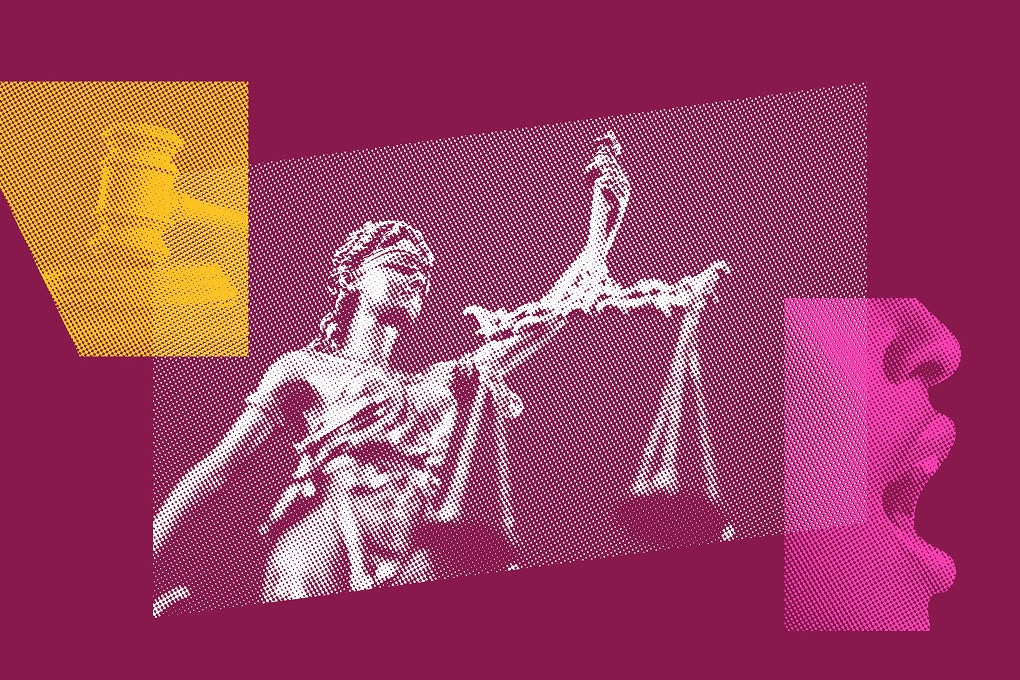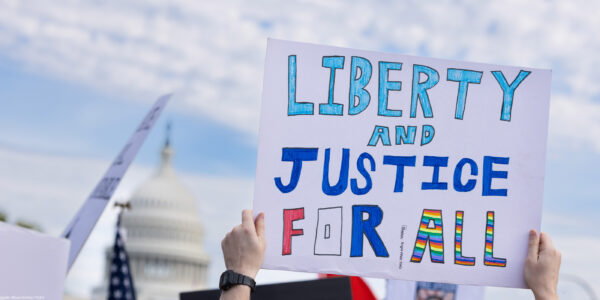We Need to Know More About State Supreme Court Cases
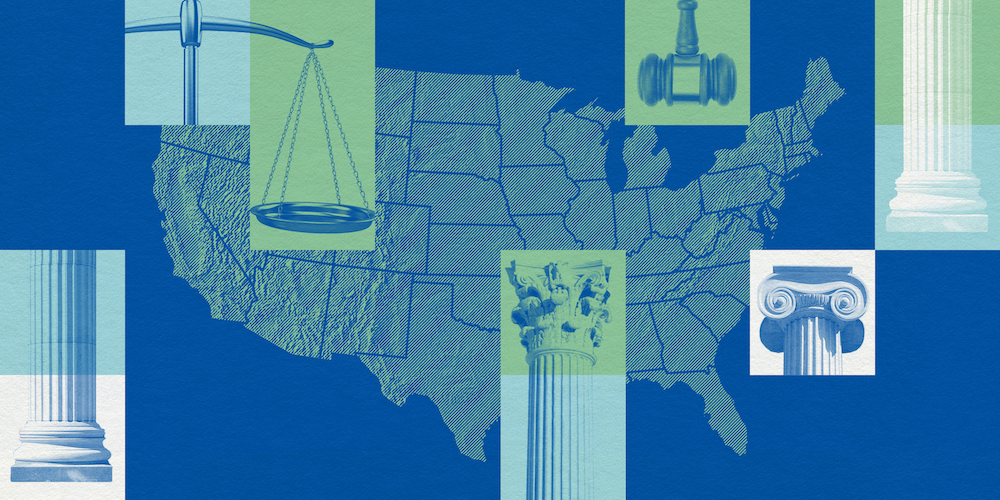
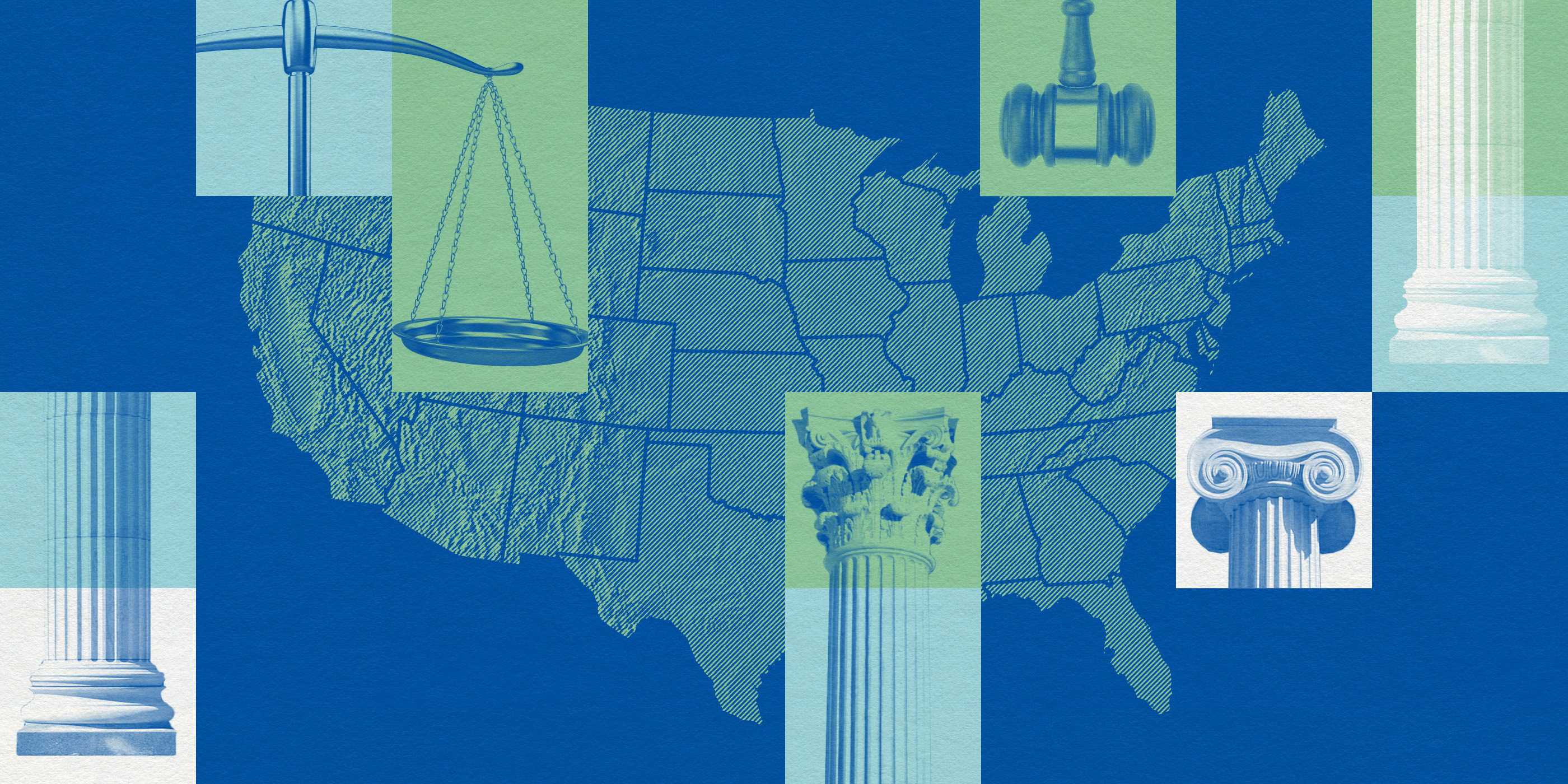
Nearly 50 years ago, former Supreme Court Justice William Brennan, Jr. observed that “state courts no less than federal are and ought to be the guardians of our liberties.”
He was right.
More than 98 percent of court cases filed in the United States are in state courts, and state courts play an outsized role in certain areas of the law, including the rights of criminal defendants and families. But state courts’ ability to guard our liberties depends in significant part on whether those courts adopt transparent processes that allow members of the public to learn about, monitor, and participate in important state court cases.
What State Supreme Courts Do for Civil Liberties
As federal courts have grown increasingly hostile to the protection of civil liberties, state supreme courts play an especially important role in protecting — and expanding — our rights. Each state has its own constitution, which can — and often does — go further than the U.S. Constitution to protect our rights. State Supreme Courts also have the final word on interpreting a state’s constitution — without threat of U.S. Supreme Court intervention.

Scorecard for State Supreme Court Transparency | American Civil Liberties Union
Accordingly, state Supreme Court decisions — much like those of the U.S. Supreme Court — have an enormous impact on our lives. State supreme courts have, for example, relied on state law to recognize the right of same-sex couples to marry, hold the death penalty unconstitutional despite contrary federal law, protect access to reproductive health care post-Dobbs, and offer more robust protection to people who have or could be subject to unreasonable searches and seizures.
Why the Public Must Know About State Supreme Court Cases
When community groups know early that a state high court is reviewing a case, they can prepare to file “friend-of-the-court” briefs educating justices about the implications of the case. We see dozens of these “friend-of-the-court" briefs in many U.S. Supreme Court cases, but they are far less common in state Supreme Court proceedings. Similarly, a state Supreme Court case docket tells the public what has happened in the case so far, and what to expect in terms of future filings. This kind of information helps citizen journalists and other media who are covering a legal issue to educate the public about the twists and turns of litigation in real time.
Importantly, in many states, Supreme Court justices are elected. Voters deserve to know not only a justice’s ultimate views on a case, but also whether the justice’s views fairly respond to the arguments from, for example, criminal defendants, employees who were fired for being Black or gay, or protestors who experienced retaliation for speaking their minds. A full assessment is only possible if you can read the legal briefs in a case.
Given the stakes, it is imperative that the public have meaningful access to pending cases in state high courts, yet access varies dramatically across the country. Some transparency is legally required by common law and the First Amendment, which gives the public a right to access certain court documents. But beyond this baseline, whether you can easily access briefs, dockets, and the issues under consideration in your state’s high court will depend on where you live.
How to Improve State Supreme Court Transparency
The ACLU’s State Supreme Court Initiative reviewed all state high courts for four key practices, all of which are already in place at the U.S. Supreme Court. These practices include posting new cases online in a timely manner, providing timely information about legal issues presented by cases, making dockets accessible and free for the public, and making merits briefing accessible and free for the public.
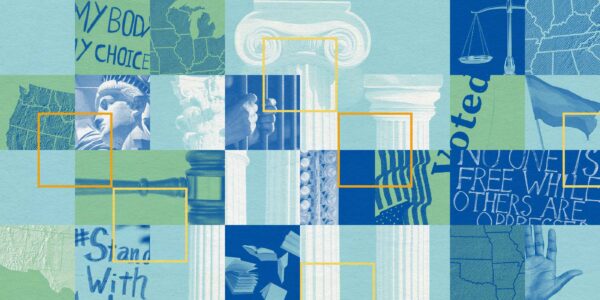
State Supreme Court Initiative | American Civil Liberties Union
Based on the ACLU’s review of the four key practices identified above, we have assigned tiers to each state and the District of Columbia. States in Tier 1 adhere to all four practices. States in Tier 5 follow none of the four practices. The results are disappointing: Most state supreme courts fall far short of providing meaningful public access to their pending cases.
Map of State Supreme Court Transparency Measures
Last updated on March 6, 2025
Alabama
Tier IV — Meets 1 of 4 Criteria
Alabama Supreme Judicial Court
❌ Regularly posts or lists new cases
❌ Provides timely information about issues presented by cases
✅ Makes dockets accessible and free for the public
❌ Makes merit briefings accessible and free for the public
Additional Information:
The Supreme Court of Alabama does not maintain any list of new or pending cases. Interested individuals can search online for decisions by the Court (leaving all other fields blank) to view lists of recent decisions and some orders from the Court, but grants of certiorari are not included in these lists. Dockets are generally searchable if the searcher knows the case information, but briefing is not.
Alaska
Tier IV — Meets 1 of 4 Criteria
Alaska Supreme Court
❌ Regularly posts or lists new cases
❌ Provides timely information about issues presented by cases
✅ Makes dockets accessible and free for the public
❌ Makes merit briefings accessible and free for the public
Additional Information:
The Alaska Supreme Court does not regularly list new cases. It does post its oral argument schedule at least a month in advance, but this posting does not include the questions presented and is typically posted too late for anyone to get involved in the case. While the Court generally has searchable case dockets, access to party briefing is inconsistent.
Arizona
Tier III — Meets 2 of 4 Criteria
Arizona Supreme Court
✅ Regularly posts or lists new cases
❌ Provides timely information about issues presented by cases
✅ Makes dockets accessible and free for the public
❌ Makes merit briefings accessible and free for the public
Additional Information:
The Arizona Supreme Court publishes a list of its decisions on petitions for review once or twice a month. This list occasionally includes the questions presented. The Court also maintains a page collecting all granted cases before the Court and awaiting decision. The Court provides case summaries for cases scheduled for oral argument, but because it typically does so on a delayed timeline, the summaries often are published too late to allow meaningful amicus participation in the case. While the Court provides generally accessible dockets for active cases, party briefing is not publicly accessible.
Arkansas
Tier II — Meets 3 of 4 Criteria
Arkansas Supreme Court
✅ Regularly posts or lists new cases
❌ Provides timely information about issues presented by cases
✅ Makes dockets accessible and free for the public
✅ Makes merit briefings accessible and free for the public
Additional Information:
The Arkansas Supreme Court posts a “Syllabus” a couple times a month that includes court proceedings, per curiam orders, motions submitted, and cases submitted. Within this syllabus, it is easy to identify cases granted review in the per curiam subsection. While these case lists do not include any description of the questions presented, they include case numbers which can be used to search for docket info and party briefing on the Court website.
California
Tier II — Meets 3 of 4 Criteria
Supreme Court of California
✅ Regularly posts or lists new cases
✅ Provides timely information about issues presented by cases
✅ Makes dockets accessible and free for the public
❌ Makes merit briefings accessible and free for the public
Additional Information:
The Supreme Court of California posts weekly lists of results from its weekly conferences. These lists identify which petitions for review were granted but does not include the questions presented. However, another page includes a regularly updated list of pending issue summaries (divided into civil and criminal issues), and the court also posts regular weekly summaries of recently accepted cases. While the case dockets are available online, party briefing is accessible on the Courts public website only after a case has been scheduled for oral argument. Finally, while not a part of our four criteria, the Court also posts weekly lists of which cases will be considered at the next conference.
Colorado
Tier III — Meets 2 of 4 Criteria
Colorado Supreme Court
✅ Regularly posts or lists new cases
✅ Provides timely information about issues presented by cases
❌ Makes dockets accessible and free for the public
❌ Makes merit briefings accessible and free for the public
Additional Information:
The Colorado Supreme Court posts a list of case announcements several times per month from September through June. Within these lists, there are subsections for granted and denied petitions for writ of certiorari. These lists include the questions presented for the granted cases. Additionally, the Court posts all original proceeding cases in which it has issued a rule to show cause, which means it requested briefing, and includes the issues in these lists. And the Court posts water appeals currently pending in the Court along with the notice of appeal. Members of the general public cannot access case dockets or party briefing.
Connecticut
Tier III — Meets 2 of 4 Criteria
Connecticut Supreme Court
❌ Regularly posts or lists new cases
❌ Provides timely information about issues presented by cases
✅ Makes dockets accessible and free for the public
✅ Makes merit briefings accessible and free for the public
Additional Information:
The Connecticut Supreme Court does not have any list of new cases. Instead, the Court regularly posts a Supreme Court Docket PDF which lists all the cases scheduled to be heard in a particular term of court, and at least some of these cases have hyperlinks to case summaries. These lists, while helpful, are posted after briefing on the cases is completed; at this point it is too late to meaningfully participate in a case. Case dockets and most briefing are accessible.
Delaware
Tier V — Meets 0 of 4 Criteria
Delaware Supreme Court
❌ Regularly posts or lists new cases
❌ Provides timely information about issues presented by cases
❌ Makes dockets accessible and free for the public
❌ Makes merit briefings accessible and free for the public
Additional Information:
There is no intermediate court in Delaware, so all appeals go to the Delaware Supreme Court. The Court does not maintain any list of new cases or the questions it is considering, nor are dockets and briefing publicly accessible online. When a case is scheduled for oral argument, the briefing is posted on the website, but by this point it is usually too late for amicus to get involved.
District of Columbia
Tier III — Meets 2 of 4 Criteria
District of Columbia Court of Appeals
❌ Regularly posts or lists new cases
❌ Provides timely information about issues presented by cases
✅ Makes dockets accessible and free for the public
✅ Makes merit briefings accessible and free for the public
Additional Coverage:
There is no intermediate court in D.C., so all appeals go to the D.C. Court of Appeals, the District’s highest court. The Court does not maintain any list of new cases or the questions it is considering. If an individual knows of a specific case, they can search for it to access the case docket. Briefing is available online thanks to recent orders aimed at increasing public access.
Florida
Tier II — Meets 3 of 4 Criteria
Florida Supreme Court
✅ Regularly posts or lists new cases
❌ Provides timely information about issues presented by cases
✅ Makes dockets accessible and free for the public
✅ Makes merit briefings accessible and free for the public
Additional Information:
The Florida Supreme Court posts a list of cases in which it has granted review. Clicking on the docket number in this list leads to an open docket with briefing available; and users can also search for dockets or briefing themselves directly on the Court’s website. The Court does not provide questions presented unless the case is listed on the Court’s high profile cases page or is scheduled for oral argument in the near future.
Georgia
Tier II — Meets 3 of 4 Criteria
Supreme Court of Georgia
✅ Regularly posts or lists new cases
✅ Provides timely information about issues presented by cases
✅ Makes dockets accessible and free for the public
❌ Makes merit briefings accessible and free for the public
Additional Information:
The Supreme Court of Georgia maintains running lists of granted petitions for certiorari, granted applications for discretionary appeal, and granted applications for interlocutory appeal. The orders linked to in these lists typically include a summary of the case and/or the issues the Court wants the briefing to focus on. One can also search for case dockets and access them easily. However, there is no briefing publicly accessible until the case is scheduled for oral argument.
Hawaii
Tier III — Meets 2 of 4 Criteria
Supreme Court of Hawai'i
✅ Regularly posts or lists new cases
❌ Provides timely information about issues presented by cases
✅ Makes dockets accessible and free for the public
❌ Makes merit briefings accessible and free for the public
Additional Information:
The Supreme Court of the State of Hawai‘i maintains a list of applications for writ of certiorari/motions for reconsideration. The issues presented are only identifiable once argument has been scheduled, usually too late for meaningful amicus participation. Dockets are accessible, but the public cannot access party briefing without paying a fee.
Idaho
Tier V — Meets 0 of 4 Criteria
Idaho Supreme Court
❌ Regularly posts or lists new cases
❌ Provides timely information about issues presented by cases
❌ Makes dockets accessible and free for the public
❌ Makes merit briefings accessible and free for the public
Additional Information:
The Idaho Supreme Court does not post cases on which it granted review or the issues presented, unless (1) it deems the matter a case of interest, which is rare (typically 2-4 times a year); or (2) (sometimes) the oral argument is coming up soon. No docket or briefing is accessible unless the Court considers the case one of interest.
Illinois
Tier IV — Meets 1 of 4 Criteria
Supreme Court of Illinois
✅ Regularly posts or lists new cases
❌ Provides timely information about issues presented by cases
❌ Makes dockets accessible and free for the public
❌ Makes merit briefings accessible and free for the public
Additional Information:
The Illinois Supreme Court publishes its Leave to Appeal dispositions and identifies which petitions for leave to appeal are allowed. No extra information is provided about cases on this page except for the case number and district court information. Questions presented and docket information are inaccessible. Briefing is also inaccessible unless the case is scheduled for oral argument or considered high-profile by the Court. Separately, the Illinois Office of the State Appellate Defender produces a regular list of criminal cases before the Supreme Court, which includes the questions presented. These cases are organized by topic.
Indiana
Tier II — Meets 3 of 4 Criteria
Indiana Supreme Court
✅ Regularly posts or lists new cases
❌ Provides timely information about issues presented by cases
✅ Makes dockets accessible and free for the public
✅ Makes merit briefings accessible and free for the public
Additional Information:
In Indiana, Court of Appeals decisions can be appealed to the Indiana Supreme Court in a motion referred to as “requesting transfer.” The Indiana Supreme Court regularly publishes a list of all motions to transfer dispositions, which lists the cases it accepted. This list does not include the questions presented. Dockets are available online. Briefing is also available online, but typically on the court of appeals docket (rather than the Supreme Court’s) because the Supreme Court usually decides the case based on the briefing in the court of appeals. Only after cases are scheduled for oral argument does the Court post the questions presented on its website.
Iowa
Tier III — Meets 2 of 4 Criteria
Iowa Supreme Court
✅ Regularly posts or lists new cases
❌ Provides timely information about issues presented by cases
✅ Makes dockets accessible and free for the public
❌ Makes merit briefings accessible and free for the public
Additional Information:
The Iowa Supreme Court maintains a list of cases in which it has granted review and a separate list of pending cases. Once a case has been scheduled for oral argument before the Court, users may be able to access party briefing and view the questions presented, but beforehand users may only access the docket of individual cases.
Kansas
Tier V — Meets 0 of 4 Criteria
Kansas Supreme Court
❌ Regularly posts or lists new cases
❌ Provides timely information about issues presented by cases
❌ Makes dockets accessible and free for the public
❌ Makes merit briefings accessible and free for the public
Additional Information:
The Kansas Supreme Court provides the oral argument schedule, which only includes the case name, counsel, and argument date and which is often posted too late for amicus involvement in a case. There is no list pending issues. The Court website includes a page for “The Kansas Appellate Case Inquiry System” to search appellate cases online, but as of early September, 2024 the system is “offline” and dockets and briefing are inaccessible.
Kentucky
Tier III — Meets 2 of 4 Criteria
Supreme Court of Kentucky
✅ Regularly posts or lists new cases
❌ Provides timely information about issues presented by cases
✅ Makes dockets accessible and free for the public
❌ Makes merit briefings accessible and free for the public
Additional Information:
The Supreme Court of Kentucky posts its monthly minutes, which list cases accepted for discretionary review. The docket numbers in these minutes links to the dockets, which are public, but the questions presented and briefing are generally not available until after oral argument is scheduled. (Access to briefing on the docket is infrequent and inconsistent). The Court maintains a separate list of pending cases and the issues presented on its main website on the side bar (“Discretionary Review Granted”) but updates are extremely infrequent and delayed.
Louisiana
Tier IV — Meets 1 of 4 Criteria
Louisiana Supreme Court
✅ Regularly posts or lists new cases
❌ Provides timely information about issues presented by cases
❌ Makes dockets accessible and free for the public
❌ Makes merit briefings accessible and free for the public
Additional Information:
The Louisiana Supreme Court posts court actions, which will include cases it has accepted for review. The Court does not provide questions presented. There are no public dockets or briefing available.
Maine
Tier V — Meets 0 of 4 Criteria
Supreme Judicial Court of Maine
❌ Regularly posts or lists new cases
❌ Provides timely information about issues presented by cases
❌ Makes dockets accessible and free for the public
❌ Makes merit briefings accessible and free for the public
Additional Information:
The Supreme Judicial Court of Maine does not have any regular list or posting of new cases and does not provide the public with the issues or questions it is considering. Nor does the Court have accessible dockets or briefing; instead, the Court typically posts the docket and briefing for cases scheduled for oral argument a few days before argument, but this is too late for meaningful participation.
Maryland
Tier II — Meets 3 of 4 Criteria
Supreme Court of Maryland
✅ Regularly posts or lists new cases
✅ Provides timely information about issues presented by cases
✅ Makes dockets accessible and free for the public
❌ Makes merit briefings accessible and free for the public
Additional Information:
The Supreme Court of Maryland has a list of certiorari petitions that it releases monthly. Issue summaries are presented for cases in which certiorari is granted. The Court also provides a separate list of cases before the Court that are scheduled for oral argument. Dockets can be searched on a separate page. However, users are unable to access party briefing with the exception of cases that the Court chooses to “highlight.”
Massachusetts
Tier I — Meets 4 of 4 Criteria
Massachusetts Supreme Judicial Court
✅ Regularly posts or lists new cases
✅ Provides timely information about issues presented by cases
✅ Makes dockets accessible and free for the public
✅ Makes merit briefings accessible and free for the public
Additional Information:
The Massachusetts Supreme Judicial Court has a regularly updated list of recently entered cases and orders, including certified questions, cases on direct review, cases on further appellate review, and sua sponte transfers. This page directly links to the petitions for review, providing easy access to the issues presented in each case. Massachusetts also has accessible dockets and briefing.
Michigan
Tier I — Meets 4 of 4 Criteria
Michigan Supreme Court
✅ Regularly posts or lists new cases
✅ Provides timely information about issues presented by cases
✅ Makes dockets accessible and free for the public
✅ Makes merit briefings accessible and free for the public
Additional Information:
The Michigan Supreme Court maintains a list of all cases in which further review has been granted but oral argument has not been scheduled, which is essentially a list of all pending cases. This list links to a summary of each case, the briefing, and links to the lower court opinions if applicable. An individual can also search for a case on the website to pull up the docket.
Minnesota
Tier II — Meets 3 of 4 Criteria
Minnesota Supreme Court
✅ Regularly posts or lists new cases
✅ Provides timely information about issues presented by cases
✅ Makes dockets accessible and free for the public
❌ Makes merit briefings accessible and free for the public
Additional Information:
The Minnesota Supreme Court regularly posts a list of granted petitions for further review, which includes the questions presented and the docket numbers. The docket number can be used to access the public docket, but the briefing is not publicly accessible. The Court also provides “issue summaries” of cases scheduled for oral argument (under “Calendar” > “Issue Summaries”).
Mississippi
Tier II — Meets 3 of 4 Criteria
Supreme Court of Mississippi
✅ Regularly posts or lists new cases
❌ Provides timely information about issues presented by cases
✅ Makes dockets accessible and free for the public
✅ Makes merit briefings accessible and free for the public
Additional Information:
The Supreme Court of Mississippi publishes a “Hand Down” list every Thursday. Besides disciplinary orders, motions, and opinions, this list also includes orders on petitions for writ of certiorari, although parties have only ten days to file supplemental briefs once certiorari has been granted. While the questions presented are not available online, individuals can search for dockets and party briefing.
Missouri
Tier II — Meets 3 of 4 Criteria
Supreme Court of Missouri
✅ Regularly posts or lists new cases
❌ Provides timely information about issues presented by cases
✅ Makes dockets accessible and free for the public
✅ Makes merit briefings accessible and free for the public
Additional Information:
In Missouri, Court of Appeals decisions can be appealed to the Supreme Court in by filing an “application for transfer.” The Court posts “Minutes” online at least once a month, and these Minutes include “sustained” applications for transfer (in other word, granted appeals). There is no readily accessible summary of the issues presented in cases before the Court (until a case is scheduled for oral argument), but the Court does provide a way to search for dockets and the party briefing.
Montana
Tier III — Meets 2 of 4 Criteria
Montana Supreme Court
❌ Regularly posts or lists new cases
❌ Provides timely information about issues presented by cases
✅ Makes dockets accessible and free for the public
✅ Makes merit briefings accessible and free for the public
Additional Information:
The Montana Supreme Court does not provide a regular list or posting of new cases or any public list of all the questions it is considering. Instead, the Court provides a list of “daily orders” that typically include dozens of orders a day, including grants of extensions of time, admission of attorneys, and published opinions, but not identifiable orders on new cases. And the Court provides a list of “cases in the news,” with select case summaries. If a member of the public knows of a specific case, they can search for it on the Court’s website and access the docket and the briefing. Individuals can also access the Court’s conference agendas to identify cases ready for classification, which means the Court will decide how to proceed with the appeal, if there will be an oral argument, if the case can be summarily dismissed, etc. However, cases typically are not scheduled for classification until briefing is finished. Additionally, the link is updated regularly and access to previous agendas is gone once updated.
Nebraska
Tier V — Meets 0 of 4 Criteria
Nebraska Supreme Court
❌ Regularly posts or lists new cases
❌ Provides timely information about issues presented by cases
❌ Makes dockets accessible and free for the public
❌ Makes merit briefings accessible and free for the public
Additional Information:
The Nebraska Supreme Court posts regular lists of outcomes on petitions for further review (“PFR”), but cases in which it grants review do not consistently appear on these lists until later stages of an appeal, such as when briefing has been submitted or oral argument has been scheduled, which does not count as a yes under our metric. Issues presented in each case are not included in this list. Dockets and briefing are not regularly accessible for cases.
Nevada
Tier III — Meets 2 of 4 Criteria
Supreme Court of Nevada
❌ Regularly posts or lists new cases
❌ Provides timely information about issues presented by cases
✅ Makes dockets accessible and free for the public
✅ Makes merit briefings accessible and free for the public
Additional Information:
While the Supreme Court of Nevada lists cases in which a petition for review has been filed, it does identify which petitions are granted or the issues they present until those cases are scheduled for oral argument. A known case number can be used to access the docket and briefing, which are public. The Court also provides a list of accepted certified questions, but it is unclear how often it is updated.
New Hampshire
Tier IV — Meets 1 of 4 Criteria
New Hampshire Supreme Court
✅ Regularly posts or lists new cases
❌ Provides timely information about issues presented by cases
❌ Makes dockets accessible and free for the public
❌ Makes merit briefings accessible and free for the public
Additional Information:
The New Hampshire Supreme Court posts a monthly PDF of all the cases in which it granted review in the previous month. It also posts a quarterly report on the status of supreme court cases. Neither of these lists include the questions presented in the cases. Dockets and briefing are not accessible online, unless the case is “frequently requested,” meaning it has “receive[d] significant public scrutiny.” The Court maintains an “ebriefs” page for cases previously decided in the calendar year; however, briefs are not available on this page prior to decision.
New Jersey
Tier III — Meets 2 of 4 Criteria
New Jersey Supreme Court
✅ Regularly posts or lists new cases
✅ Provides timely information about issues presented by cases
❌ Makes dockets accessible and free for the public
❌ Makes merit briefings accessible and free for the public
Additional Information:
The New Jersey Supreme Court maintains a regularly updated list of new appeals, including the questions presented and the docket number. As of September 4, 2024, the Court also posts all publicly filed briefs for cases being argued at least five days before oral argument, but this is too late to receive credit under our metric. The Court does not otherwise provide public docket and briefing access online.
New Mexico
Tier IV — Meets 1 of 4 Criteria
Supreme Court of New Mexico
❌ Regularly posts or lists new cases
❌ Provides timely information about issues presented by cases
✅ Makes dockets accessible and free for the public
❌ Makes merit briefings accessible and free for the public
Additional Information:
The Supreme Court of New Mexico publishes monthly Certiorari Tables, identifying petitions denied and granted. Below the tables, the Court also posts pending cases lists of all cases pending before it. Despite these resources, New Mexico gets a “no” in the first column because the Court does not typically publish these resources in a timely manner. Neither of these resources provide the questions presented. Docket information can be found online, but briefing is not publicly accessible. However, once a case is scheduled for oral argument, briefing may be accessible on the Court’s website.
New York
Tier II — Meets 3 of 4 Criteria
New York Court of Appeals
✅ Regularly posts or lists new cases
✅ Provides timely information about issues presented by cases
❌ Makes dockets accessible and free for the public
✅ Makes merit briefings accessible and free for the public
Additional Information:
The New York Court of Appeals website regularly posts a list of new case filings, including issues presented. The Court indicates that “dockets” can be searched using the case number, sometimes included in the list, or the case name, but these compilations have limited information and do not include all the docket entries, leading to a “no” in our criteria. However, party briefing is accessible to the public from these “dockets.”
North Carolina
Tier II — Meets 3 of 4 Criteria
Supreme Court of North Carolina
✅ Regularly posts or lists new cases
❌ Provides timely information about issues presented by cases
✅ Makes dockets accessible and free for the public
✅ Makes merit briefings accessible and free for the public
Additional Information:
Supreme Court of North Carolina regularly provides lists of all petitions in the Court and its rulings. Interested members of the public can search this list for “allowed” petitions for review. These lists do not include the issues or questions presented in the case. But the Court does provide online access to case briefing and docket sheets, as well as a way to search specifically for Court orders in a certain case.
North Dakota
Tier III — Meets 2 of 4 Criteria
North Dakota Supreme Court
❌ Regularly posts or lists new cases
❌ Provides timely information about issues presented by cases
✅ Makes dockets accessible and free for the public
✅ Makes merit briefings accessible and free for the public
Additional Information:
The North Dakota Supreme Court does not post a list of new cases. Instead, it provides only an oral argument schedule a few weeks in advance of argument that does not provide the questions in the case. The schedule does include a clickable docket number that will bring individuals to the docket, where they can access the briefing in the case. Occasionally, this docket will include a case summary. Dockets and briefing are available for other cases only if someone knows of a case to search. Finally, interested individuals can generate their own list of all open cases in front of the Court by searching the online portal with no inquiries other than “exclude closed cases.”
Ohio
Tier I — Meets 4 of 4 Criteria
Supreme Court of Ohio
✅ Regularly posts or lists new cases
✅ Provides timely information about issues presented by cases
✅ Makes dockets accessible and free for the public
✅ Makes merit briefings accessible and free for the public
Additional Information:
The Supreme Court of Ohio website regularly posts case announcements that may include a section of “Appeals accepted for review.” Clicking on the case docket number leads to an open public docket with accessible briefing. The Court does not post questions presented concurrently with these lists but may indicate on which proposition(s) of law the appeal was granted, and those proposition(s) can be found in the jurisdictional brief accessible on the docket. Additionally, a different link collects all “issues accepted for review.”
Oklahoma
Tier III — Meets 2 of 4 Criteria
Oklahoma Court of Criminal Appeals (Criminal)
❌ Regularly posts or lists new cases
❌ Provides timely information about issues presented by cases
✅ Makes dockets accessible and free for the public
✅ Makes merit briefings accessible and free for the public
Oklahoma Supreme Court (Civil)
❌ Regularly posts or lists new cases
❌ Provides timely information about issues presented by cases
✅ Makes dockets accessible and free for the public
✅ Makes merit briefings accessible and free for the public
Additional Information:
The Oklahoma Court of Criminal Appeals does not include any regular list or posting of new cases or issues. If an individual already knows of a case, however, they can search for the docket and access the briefing.
The Oklahoma Supreme Court also does not include any regular list or posting of new cases or issues. If an individual already knows of a case, however, they can search for the docket and access the briefing.
Oregon
Tier II — Meets 3 of 4 Criteria
Oregon Supreme Court
✅ Regularly posts or lists new cases
✅ Provides timely information about issues presented by cases
✅ Makes dockets accessible and free for the public
❌ Makes merit briefings accessible and free for the public
Additional Information:
The Oregon Supreme Court posts regular media releases, which may contain “Allowed petitions for review,” a section that includes summaries of the cases granted and the issues on review. With a free account, the docket number can be used to search and access the docket, but the briefing is inaccessible to the public. Briefing is usually accessible for cases scheduled for oral argument, but not early enough to allow for meaningful participation.
Pennsylvania
Tier IV — Meets 1 of 4 Criteria
Supreme Court of Pennsylvania
❌ Regularly posts or lists new cases
❌ Provides timely information about issues presented by cases
✅ Makes dockets accessible and free for the public
❌ Makes merit briefings accessible and free for the public
Additional Information:
The Supreme Court of Pennsylvania allows individuals to search for orders on petitions for allowance of appeal from any date range. Granted appeals are labeled as such, and the orders include the issues presented. However, despite these resources, the Court still receives a “no” for the first two categories because cases accepted through the petitions for allowance of appeal are a minority of cases. The majority of cases come to the Court through other means, and there is no public list of those cases or summary of the issues presented. If an individual knows of a case, they can search for case dockets, but briefing is not publicly available online.
Rhode Island
Tier IV — Meets 1 of 4 Criteria
Rhode Island Supreme Court
❌ Regularly posts or lists new cases
❌ Provides timely information about issues presented by cases
✅ Makes dockets accessible and free for the public
❌ Makes merit briefings accessible and free for the public
Additional Information:
The Rhode Island Supreme Court does not provide any regular posting of new cases or of the issues it is currently considering (only issues it has already decided). If an individual knows of a specific case, they can access the docket but no briefing.
South Carolina
Tier II — Meets 3 of 4 Criteria
Supreme Court of South Carolina
✅ Regularly posts or lists new cases
❌ Provides timely information about issues presented by cases
✅ Makes dockets accessible and free for the public
✅ Makes merit briefings accessible and free for the public
Additional Information:
The Supreme Court of South Carolina posts “Advance Sheets” several times a month. These sheets include actions on petition for certiorari and a list of petitions still pending. There is no list of issues presented in those cases until the oral argument is coming up soon, which is too late for meaningful participation. Dockets and briefing are publicly accessible online.
South Dakota
Tier V — Meets 0 of 4 Criteria
South Dakota Supreme Court
❌ Regularly posts or lists new cases
❌ Provides timely information about issues presented by cases
❌ Makes dockets accessible and free for the public
❌ Makes merit briefings accessible and free for the public
Additional Information:
The South Dakota Supreme Court does not have any regular list or posting of new cases or the issues those cases present, and dockets and briefing are not publicly accessible. For past cases, the Court maintains a “term of court” page listing cases heard in certain months, and for cases with an oral argument, that page links to briefing.
Tennessee
Tier II — Meets 3 of 4 Criteria
Tennessee Supreme Court
✅ Regularly posts or lists new cases
✅ Provides timely information about issues presented by cases
✅ Makes dockets accessible and free for the public
❌ Makes merit briefings accessible and free for the public
Additional Information:
The Tennessee Supreme Court posts regular “discretionary appeals” lists indicating when appeals are granted or denied. The issues presented can be found in a separate pending case report, although its updates are sometimes delayed. Each docket is accessible, but public access to filings online is inconsistent.
Texas
Tier I/II — Meets 3 (Civil) or 4 (Criminal) of 4 Criteria
Texas Court of Criminal Appeals (Criminal)
✅ Regularly posts or lists new cases
✅ Provides timely information about issues presented by cases
✅ Makes dockets accessible and free for the public
✅ Makes merit briefings accessible and free for the public
Supreme Court of Texas (Civil)
✅ Regularly posts or lists new cases
❌ Provides timely information about issues presented by cases
✅ Makes dockets accessible and free for the public
✅ Makes merit briefings accessible and free for the public
Additional Information:
The Texas Court of Criminal Appeals’ website includes an “Issues Granted” tab that links to regularly updated PDFs of pending issues before the Court, either from petitions for discretionary review or state habeas claims. Once a week, the Court also releases a compilation of the orders and opinions for that week, which includes the results for petitions for discretionary review and writs of habeas corpus. Finally, the Court also makes dockets and briefing accessible to members of the public.
The Supreme Court of Texas releases a summary order almost every week that includes new grants on petitions for review, certified questions accepted from the federal courts, and cases accepted for rehearing. The Court also maintains a “causes” page that includes cases set for oral argument, cases not set for oral argument, and cases that have been submitted for oral argument. But neither of these resources lists the questions presented in a case. The Court does make dockets and briefing accessible to members of the public if they are interested in figuring out the issues presented themselves, however.
Utah
Tier III — Meets 2 of 4 Criteria
Utah Supreme Court
❌ Regularly posts or lists new cases
✅ Provides timely information about issues presented by cases
✅ Makes dockets accessible and free for the public
❌ Makes merit briefings accessible and free for the public
Additional Information:
The Utah Supreme Court maintains a page of granted petitions for certiorari, including the issues presented in each of those cases, but the Court does not update this page in a timely manner. For example, a petition that was granted in May 2024 was not put on the website until July 2024. Case dockets are also accessible to members of the public, but briefing is not.
Vermont
Tier III — Meets 2 of 4 Criteria
Vermont Supreme Court
❌ Regularly posts or lists new cases
❌ Provides timely information about issues presented by cases
✅ Makes dockets accessible and free for the public
✅ Makes merit briefings accessible and free for the public
Additional Information:
The Vermont Supreme Court does not have any regular posting of new cases available to the public. The Court posts its oral argument schedule around a month in advance, but this schedule does not include the issues presented. The Court does have an online search system where users can search for and access case dockets and most party merits briefing.
Virginia
Tier III — Meets 2 of 4 Criteria
Supreme Court of Virginia
✅ Regularly posts or lists new cases
✅ Provides timely information about issues presented by cases
❌ Makes dockets accessible and free for the public
❌ Makes merit briefings accessible and free for the public
Additional Information:
The Supreme Court of Virginia maintains an “appeals granted” page on its website, which includes all granted appeals and the questions presented in those appeals. But the Court does not provide public access to full case dockets or merits briefing, instead providing limited information on each case.
Washington
Tier I — Meets 4 of 4 Criteria
Washington Supreme Court
✅ Regularly posts or lists new cases
✅ Provides timely information about issues presented by cases
✅ Makes dockets accessible and free for the public
✅ Makes merit briefings accessible and free for the public
Additional Information:
The Washington Supreme Court’s comprehensive website includes a list of all recent petitions for review, a list of accepted cases, and a regularly updated list of pending Supreme Court issues. Case dockets are searchable online, and the Court also posts all briefing on its website. Finally, the Court allows anyone to sign up for email notifications for “Supreme Court Granted Cases,” making it easy to be notified of new cases without regularly checking for updates.
West Virginia
Tier IV — Meets 1 of 4 Criteria
Supreme Court of Appeals of West Virginia
✅ Regularly posts or lists new cases
❌ Provides timely information about issues presented by cases
❌ Makes dockets accessible and free for the public
❌ Makes merit briefings accessible and free for the public
Additional Information:
The Supreme Court of Appeals of West Virginia posts order lists approximately every month; those lists set new cases for oral argument and include other dispositions on petitions for review. The lists do not include the issues presented. Dockets and briefing are not generally available online, but briefs are inconsistently available in some cases once they are scheduled for oral argument, a point at which is too late for meaningful amicus participation.
Wisconsin
Tier I — Meets 4 of 4 Criteria
Wisconsin Supreme Court
✅ Regularly posts or lists new cases
✅ Provides timely information about issues presented by cases
✅ Makes dockets accessible and free for the public
✅ Makes merit briefings accessible and free for the public
Additional Information:
The Wisconsin Supreme Court maintains a regularly updated table of all pending cases the Court has accepted for review, including the issues presented, the date of oral argument, and citations to the Court of Appeals opinions when applicable. The Court also maintains an online case search function that allows individuals to view case dockets and briefing.
Wyoming
Tier III — Meets 2 of 4 Criteria
Supreme Court of Wyoming
❌ Regularly posts or lists new cases
❌ Provides timely information about issues presented by cases
✅ Makes dockets accessible and free for the public
✅ Makes merit briefings accessible and free for the public
Additional Information:
The Supreme Court of Wyoming does not provide any regular list or posting of new cases or identify the issues presented by its pending cases. The Court does maintain a search function allowing users to search for cases by issue areas-- i.e., a user could search for all “Civil Rights” cases filed in a certain time period. If a user finds a case this way or is otherwise aware of a certain case, the user can access dockets and briefing through the same site.
As demonstrated in the map above, only six state Supreme Courts — those in Massachusetts, Michigan, Ohio, Texas (Criminal), Washington, and Wisconsin — qualify for Tier 1. In contrast, six state high courts fall into Tier 5, meaning they do not follow any of the identified transparency practices, and another 26 of them follow only one or two of those key practices. Many state supreme courts thus have a long way to go in providing information to the public commensurate with their important role in our nation’s legal system.
Fortunately, state Supreme Courts with room to improve need not recreate the wheel. Ready examples exist in state high courts around the country and in the U.S. Supreme Court, and these examples could, at minimum, serve as a model for state-specific modification.
Where possible, we therefore link to examples on state high court websites in the information provided with each state, with the hope that these examples help courts and advocates who appear before them identify promising practices that could be replicated in their states. Everyone benefits from transparency into our court system. It’s up to all of us to demand that our states’ highest courts set a high bar.
